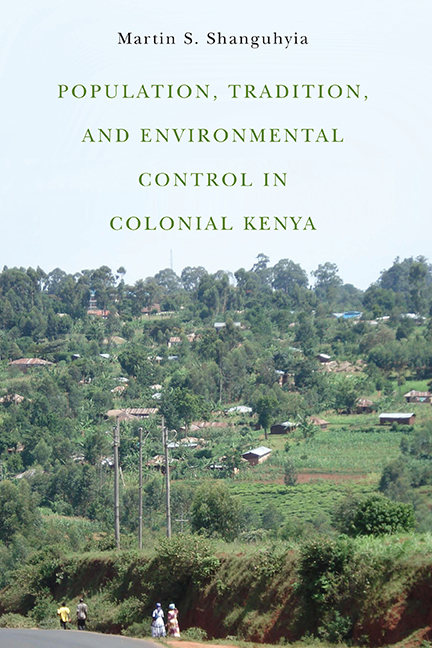Book contents
- Frontmatter
- Contents
- List of Illustrations
- Preface
- Abbreviations
- Introduction
- 1 Administrative and Demographic Changes: Implications on Land Relations, 1900–1930
- 2 Maize and Economic Prosperity, 1920–38
- 3 Internationalizing Degradation Narratives in Kenya, 1930–38
- 4 Prewar Soil Conservation Initiatives and Local Responses, 1934–38
- 5 Wartime Production in a Besieged Environment, 1939–45
- 6 Postwar Development and the Dilemma of “Reviving” African Traditions, 1945–63
- 7 Regional Migration and Failed Agricultural Intensification, 1940–66
- Conclusion
- Notes
- Bibliography
- Index
- Frontmatter
- Contents
- List of Illustrations
- Preface
- Abbreviations
- Introduction
- 1 Administrative and Demographic Changes: Implications on Land Relations, 1900–1930
- 2 Maize and Economic Prosperity, 1920–38
- 3 Internationalizing Degradation Narratives in Kenya, 1930–38
- 4 Prewar Soil Conservation Initiatives and Local Responses, 1934–38
- 5 Wartime Production in a Besieged Environment, 1939–45
- 6 Postwar Development and the Dilemma of “Reviving” African Traditions, 1945–63
- 7 Regional Migration and Failed Agricultural Intensification, 1940–66
- Conclusion
- Notes
- Bibliography
- Index
Summary
While traveling through Maragoli in western Kenya in 1947, the British journalist Negley Farson narrated vivid images that left no doubt that population density was an impediment to the welfare of the land and to the subsistence of the local families. “In some parts of South Maragoli,” Negley wrote, “the population is over 900 to the square mile. I have stood on one plot of land in that territory where four families were trying to make a living … on 2¼ acres … on a 47-degree slope, at a place called Lotego, near Majengo, in South Maragoli—four families in four huts; twenty five people, on 2¼ acres, planted in cassava, sorghum and early maize.” Farson's observations reflected the true picture of the rural landscapes at a time British colonial authorities launched concerted efforts to arrest serious incidences of land degradation in this part of Kenya. High population densities and the resulting acute land shortages were just two of several reasons cited by colonial authorities for the declining quality of the land in the area. Aggressive soil conservation campaigns had been launched there since the mid-1930s with minimal results. This was the case in spite of aggressive policies to enforce conventional land management methods and a relentless push to integrate traditional values and institutions of the local populations.
Today, when one travels through Maragoli and the adjoining Bunyore, Tiriki, and Nyang’ori Locations, Farson's images remain accurate, except that farm sizes have shrunk further since the 1940s. Agricultural fortunes began to decline in the closing years of colonial rule, a distant reflection of the “golden age” this region enjoyed as a major contributor to the colonial economy during the 1920s and 1930s. It is this transformation of the area, particularly during the colonial period, that this book explores. More often than not, the rural agricultural and environmental programs pursued by most colonial administrations in Africa failed to yield the desired social and economic order. Rarely did they achieve environmental stability in the fragile rural ecologies. By drawing from demographic and environmental challenges that faced a section of the Abaluyia community in western Kenya, I make the case that reasons for this failure were very complicated.
- Type
- Chapter
- Information
- Publisher: Boydell & BrewerPrint publication year: 2015



